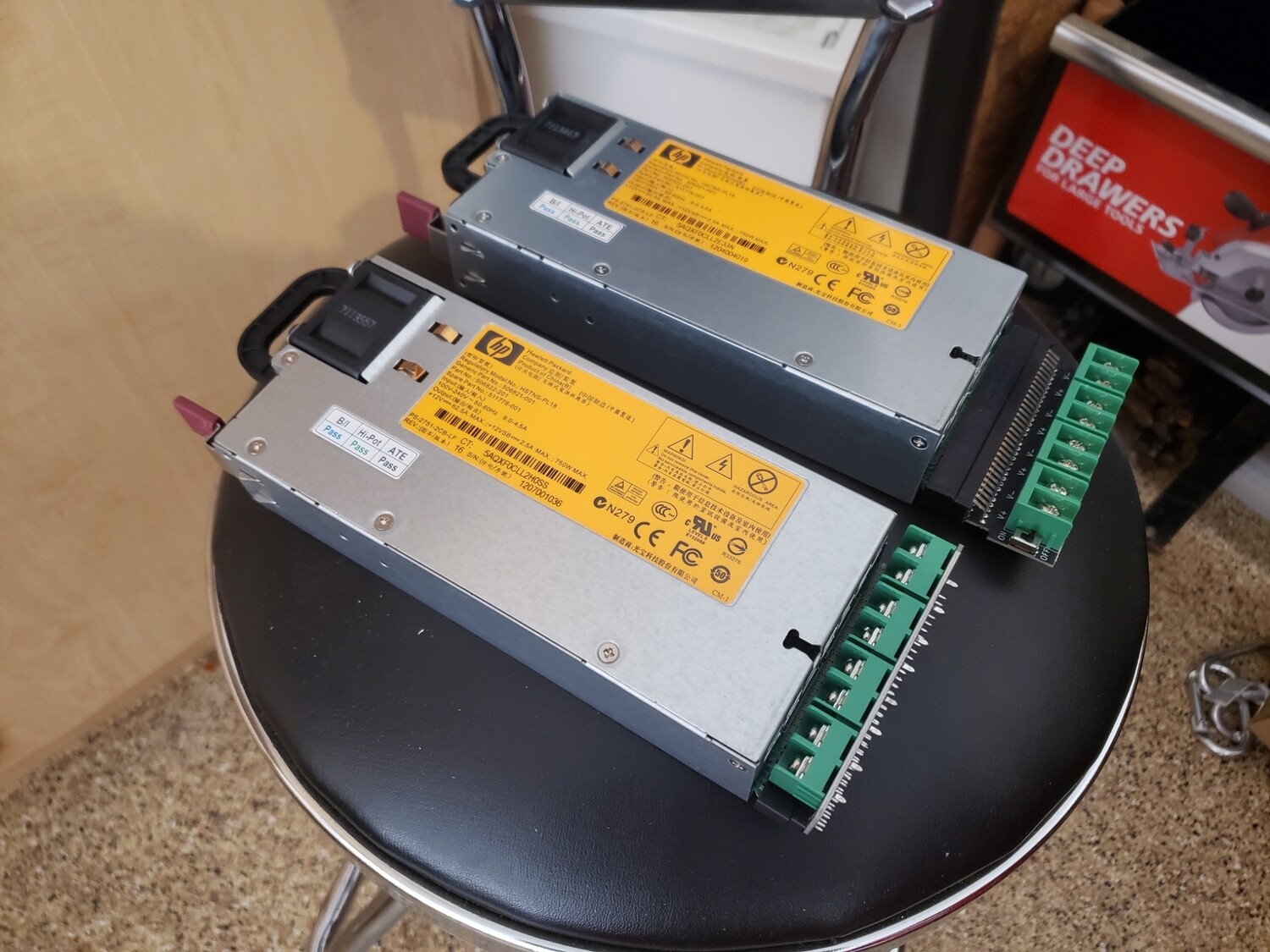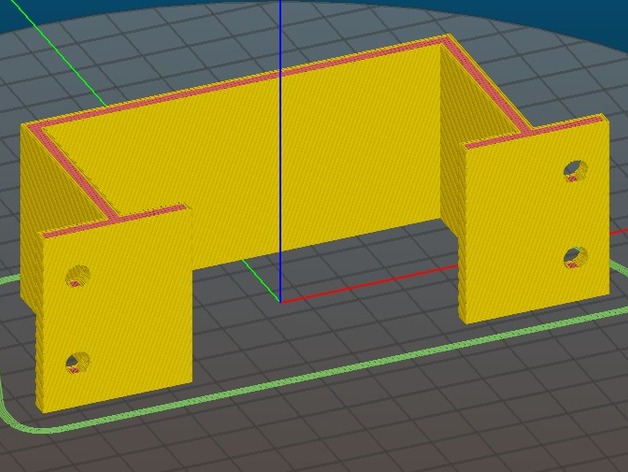LawrenceDriveLights
Senior elf
- Joined
- Jan 16, 2018
- Messages
- 582
There has been a great amount of chat lately of the HP Server 12V 100 Amp PSU, in particular from some of the people in this hobby from the USA.
So I was interested to find out what all the fuss was about so to speak
Background;
I have been using a number of the Meanwell LRS-350-12 PSU in my display and in particular for some dense pixel props like my MegaTree have used up to 3 or 4 of them inside a enclosure which has been working great and no issues at all over the past two seasons.
One of the reasons I have no PSU failures so far is I am not running them all the time at 100% capacity and mostly only around the 50% capacity for a number of reasons, one in particular even though I don't run pixels at 100% brightness I do try and design my display to run close to this for safety reasons and a nice margin for error etc when I am determining the current draw of my display.
Now before you say, I run 2000 or whatever amount of pixels from one generic type Chinese 12v 30 amp PSU, or 5v is better cause they are more efficient etc and haven't had a issue yet, this is probably fine and I am not expert in this and like many aspects of this hobby there is multiple ways of achieving the same outcome ie make our pixels flash in time to the music . Wow that sounded like some kind of disclaimer.
. Wow that sounded like some kind of disclaimer.
Anyway
Now it seems these server PSU have been used for a number of years for various other reasons after they have been removed from their intended use, which is a number of them powering servers.
I have seen these used for powering bitcoin mining type setups, used in the RC hobby for powering battery chargers etc and now of later being adapted for use in this hobby.
I purchased a number of these and on first inspection they do appear a nice option for a 12v PSU in particular the price if you start doing a comparison $ / Amp compared to say the Meanwell PSU's.
A couple of downsides to these server type PSU is that they require a little modification to be used, ie to output 12v and the outputs connectors don't have a simple way of connecting any cable to. Now some people have fitted a resistor etc across the required outputs and managed to solder suitable sized cables to the outputs but this seemed a little messy for me, but again there is multiple ways of achieving the same outcome.
The solution to this to use a Breakout board which has modification to allow the server PSU to output and also allow easier cable connections etc.
There is a couple ready made options available after a super quick search, some are on Ebay and such and advertised for https://www.ebay.com.au/itm/Breakou...543079?hash=item1a8439ff27:g:rp8AAOSw7PNdfEgW and a couple of other similar options which seemed ok.
I was concerned by the current capacity of each one of the outputs as they list the outputs as up to 14 AWG which could be ok.
I then noticed these breakout boards

 jboards.ecwid.com
jboards.ecwid.com
These did seem a little more suitable for my needs in particular a small board and each output capable of up to 32A and allows up to 10 AWG according to their website specs , and since I have noticed there is a couple of other options like with fuses and vertical connectors etc.
I received the Server PSU and was pleasantly surprised they all seem in great condition as per the sellers listing with not obvious damage etc.
The first thing I noticed was the actually size of them, they are smaller than I first thought which is handy.
Here is a size comparison
 View: https://www.dropbox.com/s/yz63kpblm0urb3z/Photo%2020-1-20%2C%202%2035%2047%20pm.jpg?dl=0
View: https://www.dropbox.com/s/yz63kpblm0urb3z/Photo%2020-1-20%2C%202%2035%2047%20pm.jpg?dl=0
I then received the breakout boards and these also seemed as per sellers description
I then fitted the breakout board which was simple as it just slides on the Server PSU outputs (it is a snug fit) and supplied 240v power via a IEC C13 style lead (commonly used for PC power connections and other type of electronics, you can purchase from various outlets including Bunnings! https://www.bunnings.com.au/jackson-1-2m-replacement-iec-power-lead_p4420134
It powered up as per it should with the fan running all the time (which seem to have a very good airflow) and the green LED indicating powered on.
I then checked the output voltage, and as expected was slightly over 12V, this one measured 12.31V with no load.
 View: https://www.dropbox.com/s/jyf8nsl2h3waijm/Photo%202-2-20%2C%203%2005%2015%20pm.jpg?dl=0
View: https://www.dropbox.com/s/jyf8nsl2h3waijm/Photo%202-2-20%2C%203%2005%2015%20pm.jpg?dl=0
I was curious to see if this voltage would drop with some load applied, so I connected up some 12V lights etc I had handy and was pulling just on 40 amps from the server PSU.
There was a very slight voltage drop measured at the outputs 12.29V (could also be variation in multi meter) again I am no expert.
 View: https://www.dropbox.com/s/ggdw49a4moqyd41/Photo%202-2-20%2C%203%2021%2041%20pm.jpg?dl=0
View: https://www.dropbox.com/s/ggdw49a4moqyd41/Photo%202-2-20%2C%203%2021%2041%20pm.jpg?dl=0
So all appeared ok, and I left it running like this for about 45 minutes and use the temp of the server did increase, all seemed ok.
I then adjusted the PSU with the same load applied to 12V (I wont go into details on how to this, just saying be careful of what instructions you find on the internet as there seems to be a couple of variations of this type of PSU). Some would say the slighter higher voltage wouldn't be a issue, but I also adjust my Meanwells close to 12.0V so wanted to do the same with these.
 View: https://www.dropbox.com/s/4mbarbb9m3xrrxj/Photo%202-2-20%2C%203%2035%2014%20pm.jpg?dl=0
View: https://www.dropbox.com/s/4mbarbb9m3xrrxj/Photo%202-2-20%2C%203%2035%2014%20pm.jpg?dl=0
So I was interested to find out what all the fuss was about so to speak
Background;
I have been using a number of the Meanwell LRS-350-12 PSU in my display and in particular for some dense pixel props like my MegaTree have used up to 3 or 4 of them inside a enclosure which has been working great and no issues at all over the past two seasons.
One of the reasons I have no PSU failures so far is I am not running them all the time at 100% capacity and mostly only around the 50% capacity for a number of reasons, one in particular even though I don't run pixels at 100% brightness I do try and design my display to run close to this for safety reasons and a nice margin for error etc when I am determining the current draw of my display.
Now before you say, I run 2000 or whatever amount of pixels from one generic type Chinese 12v 30 amp PSU, or 5v is better cause they are more efficient etc and haven't had a issue yet, this is probably fine and I am not expert in this and like many aspects of this hobby there is multiple ways of achieving the same outcome ie make our pixels flash in time to the music
Anyway
Now it seems these server PSU have been used for a number of years for various other reasons after they have been removed from their intended use, which is a number of them powering servers.
I have seen these used for powering bitcoin mining type setups, used in the RC hobby for powering battery chargers etc and now of later being adapted for use in this hobby.
I purchased a number of these and on first inspection they do appear a nice option for a 12v PSU in particular the price if you start doing a comparison $ / Amp compared to say the Meanwell PSU's.
A couple of downsides to these server type PSU is that they require a little modification to be used, ie to output 12v and the outputs connectors don't have a simple way of connecting any cable to. Now some people have fitted a resistor etc across the required outputs and managed to solder suitable sized cables to the outputs but this seemed a little messy for me, but again there is multiple ways of achieving the same outcome.
The solution to this to use a Breakout board which has modification to allow the server PSU to output and also allow easier cable connections etc.
There is a couple ready made options available after a super quick search, some are on Ebay and such and advertised for https://www.ebay.com.au/itm/Breakou...543079?hash=item1a8439ff27:g:rp8AAOSw7PNdfEgW and a couple of other similar options which seemed ok.
I was concerned by the current capacity of each one of the outputs as they list the outputs as up to 14 AWG which could be ok.
I then noticed these breakout boards

Server Basic Breakout Board - Vertical Only - Preorder
Horizontal version runs parallel with the power supply Vertical version runs perpendicular with the power supply This breakout board works with the common HP common slot server power supplies such as the 480W, 750W and 1200W varieties. Easy connection is made via the edge slot connector. 4...
 jboards.ecwid.com
jboards.ecwid.com
These did seem a little more suitable for my needs in particular a small board and each output capable of up to 32A and allows up to 10 AWG according to their website specs , and since I have noticed there is a couple of other options like with fuses and vertical connectors etc.
I received the Server PSU and was pleasantly surprised they all seem in great condition as per the sellers listing with not obvious damage etc.
The first thing I noticed was the actually size of them, they are smaller than I first thought which is handy.
Here is a size comparison

I then received the breakout boards and these also seemed as per sellers description
I then fitted the breakout board which was simple as it just slides on the Server PSU outputs (it is a snug fit) and supplied 240v power via a IEC C13 style lead (commonly used for PC power connections and other type of electronics, you can purchase from various outlets including Bunnings! https://www.bunnings.com.au/jackson-1-2m-replacement-iec-power-lead_p4420134
It powered up as per it should with the fan running all the time (which seem to have a very good airflow) and the green LED indicating powered on.
I then checked the output voltage, and as expected was slightly over 12V, this one measured 12.31V with no load.

I was curious to see if this voltage would drop with some load applied, so I connected up some 12V lights etc I had handy and was pulling just on 40 amps from the server PSU.
There was a very slight voltage drop measured at the outputs 12.29V (could also be variation in multi meter) again I am no expert.

So all appeared ok, and I left it running like this for about 45 minutes and use the temp of the server did increase, all seemed ok.
I then adjusted the PSU with the same load applied to 12V (I wont go into details on how to this, just saying be careful of what instructions you find on the internet as there seems to be a couple of variations of this type of PSU). Some would say the slighter higher voltage wouldn't be a issue, but I also adjust my Meanwells close to 12.0V so wanted to do the same with these.












